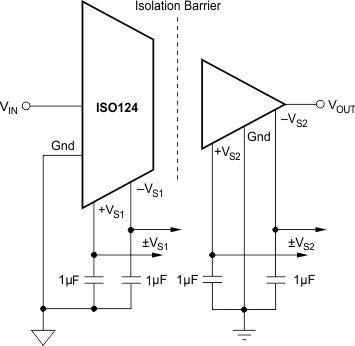SBOS074E September 1997 – June 2018 ISO124
PRODUCTION DATA.
- 1 Features
- 2 Applications
- 3 Description
- 4 Revision History
- 5 Pin Configuration and Functions
- 6 Specifications
- 7 Detailed Description
-
8 Application and Implementation
- 8.1 Application Information
- 8.2
Typical Applications
- 8.2.1 Output Filters
- 8.2.2 Battery Monitor
- 8.2.3 Programmable Gain Amplifier
- 8.2.4 Thermocouple Amplifier
- 8.2.5 Isolated 4-mA to 20-mA Instrument Loop
- 8.2.6 Single-Supply Operation of the ISO124 Isolation Amplifier
- 8.2.7 Input-Side Powered ISO Amplifier
- 8.2.8 Powered ISO Amplifier With Three-Port Isolation
- 9 Power Supply Recommendations
- 10Layout
- 11Device and Documentation Support
- 12Mechanical, Packaging, and Orderable Information
Package Options
Refer to the PDF data sheet for device specific package drawings
Mechanical Data (Package|Pins)
- NVF|8
- DVA|8
Thermal pad, mechanical data (Package|Pins)
Orderable Information
9.1 Signal and Supply Connections
Each power-supply pin should be bypassed with 1-µF tantalum capacitors located as close to the amplifier as possible. The internal frequency of the modulator/demodulator is set at 500 kHz by an internal oscillator. Therefore, if it is desired to minimize any feedthrough noise (beat frequencies) from a DC-DC converter, use a π filter on the supplies (see Figure 10). The ISO124 output has a 500-kHz ripple of 20 mV, which can be removed with a simple 2-pole low-pass filter with a 100-kHz cutoff using a low-cost op amp (see Figure 10).
The input to the modulator is a current (set by the 200-kΩ integrator input resistor) that makes it possible to have an input voltage greater than the input supplies, as long as the output supply is at least ±15 V. It is therefore possible, when using an unregulated DC-DC converter, to minimize PSR related output errors with ±5-V voltage regulators on the isolated side and still get the full ±10-V input and output swing.
 Figure 24. Basic Signal and Power Connections
Figure 24. Basic Signal and Power Connections